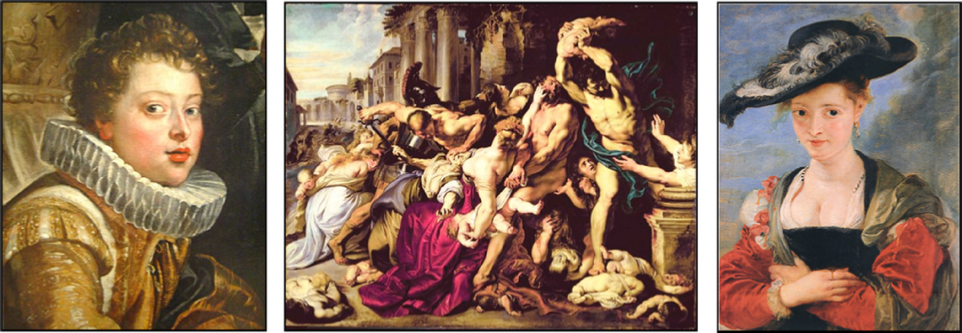


PETER PAUL RUBENS
1577 -
Acknowledgements
Rubens: Self-
Including:
Baroque Art

xxxxxIllustrated
here are The Duke of Mantua, Massacre
of the Innocents, and the so-
xxxxxRubens worked
long hours and with speed and dexterity. He perfected his own
colour technique by applying his paint in thin layers -
xxxxxIncidentally, in his landscape The Harvest Wagon, painted around 1767, the English artist Gainsborough positioned the occupants of the cart so as to resemble the composition of the figures in Rubens' Descent from the Cross. ......
 xxxxx...... The breed of toy dog
known as Papillon (French for
"butterfly") -
xxxxx...... The breed of toy dog
known as Papillon (French for
"butterfly") -
xxxxx…… In 2002 his Biblical story Massacre of the Innocents was auctioned in London for the record sum of £49.5 million.
xxxxxThe works of the Flemish baroque artist Peter Paul Rubens are full of rich, radiant colours which create a feeling of great energy and zest for life. His output was phenomenal. Over 40 years he and his studio produced more than 2,000 paintings. Most have religious, allegorical or mythological themes, but towards the end of his career he produced scenes of country life, and he was also an accomplished portrait artist with a reputation for his portrayal of tenderness. His The Rape of the Daughters of Leucippus, painted in 1618, fully captures the essence of his distinctive style, as does his Fall of the Damned. These also include the voluptuous female nudes which are a feature of his work as a leading baroque artist. In the early 1600s he produced some magnificent religious compositions, such as his two altarpieces The Raising of the Cross and The Descent from the Cross in 1611. Among his many patrons were Louis XIII of France, Charles I of England, and Philip IV of Spain. His style influenced many painters throughout Europe. When not painting he often acted as a diplomat, and was sent on a number of missions.
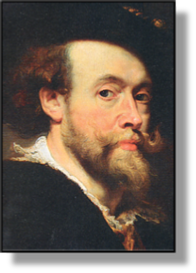 xxxxxA love of rich, radiant colours, a feeling of great
energy and power, and a sensuous portrayal of the human form are
the hallmarks of the great baroque artist Peter Paul Rubens. Few
painters have equalled the sheer visual impact of this brilliant
Flemish technician. And his output was phenomenal, making him one
of the most prolific painters of all time, and earning him an
international reputation by the age of 30. Over a period of some
40 years he and his studio produced more than 2,000 paintings,
including many huge compositions. Most of these works depicted
religious, allegorical or mythological themes and were painted for
churches and palaces throughout Europe. (The painting on the left
is a self-
xxxxxA love of rich, radiant colours, a feeling of great
energy and power, and a sensuous portrayal of the human form are
the hallmarks of the great baroque artist Peter Paul Rubens. Few
painters have equalled the sheer visual impact of this brilliant
Flemish technician. And his output was phenomenal, making him one
of the most prolific painters of all time, and earning him an
international reputation by the age of 30. Over a period of some
40 years he and his studio produced more than 2,000 paintings,
including many huge compositions. Most of these works depicted
religious, allegorical or mythological themes and were painted for
churches and palaces throughout Europe. (The painting on the left
is a self-
xxxxxLater, he
went on the produce scenes of country life, and in retirement he
painted a number of tranquil, mellow landscapes, including one
showing a view of his country estate at his Chateau
de Steen. And to these last years of his life belongs a
series of classical paintings for Philip IV's hunting lodge near
Madrid. He was also an accomplished portrait artist in oil, chalk
and crayon, and in this field he is particularly noted for his
portrayal of tenderness -
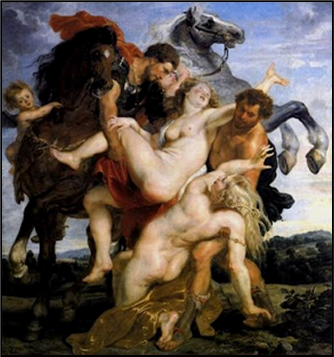 xxxxxOne of his masterpieces, The Rape
of the Daughters of Leucippus (illustrated), painted in 1618, fully captures the essence of his
distinctive style. This work, together with his St.
George and the Dragon of 1610, and his Fall
of the Damned, completed around 1620, epitomise the vibrant
colours, the dynamic composition, and the voluptuous female nudes
which make up the vital ingredients of baroque.
This art form had already begun to appear in Italy in the works of
Caravaggio and Annibale Carracci, but it was Rubens who brought it to Northern Europe and
earned for himself the title of the "Creator of Baroque".
xxxxxOne of his masterpieces, The Rape
of the Daughters of Leucippus (illustrated), painted in 1618, fully captures the essence of his
distinctive style. This work, together with his St.
George and the Dragon of 1610, and his Fall
of the Damned, completed around 1620, epitomise the vibrant
colours, the dynamic composition, and the voluptuous female nudes
which make up the vital ingredients of baroque.
This art form had already begun to appear in Italy in the works of
Caravaggio and Annibale Carracci, but it was Rubens who brought it to Northern Europe and
earned for himself the title of the "Creator of Baroque".
xxxxxHe was born in Siegen in Germany, but on the death of his father, a lawyer who had been forced into exile, his mother returned to Antwerp. It was here that he was educated at the Latin School and then spent a short time as a page at the court of the Countess Lalaing. His main interest lay in painting, however, and after studying art, he became a member of the city's Guild of Painters in 1598. Success came with his move to Italy two years later. Here he was court painter to the Duke of Mantua, and quickly gained a reputation for his church paintings and his many portraits of the local nobility.
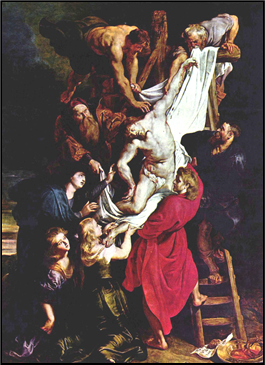
xxxxxAnd it was while travelling in Italy that the works of Titian, Veronese and Tintoretto in Venice, and those of Michelangelo and Raphael in Rome, had a profound effect upon his future style. No sooner had he returned to Antwerp in 1609 than he was appointed painter to the court of the Archduke Albert and the Infanta Isabella, the Spanish Habsburg regents in Flanders. From then on his career took off. Over the next ten years or so he produced some magnificent religious compositions for the Cathedral and the Jesuit Church in Antwerp. Works in this period included his Massacre of the Innocents and two magnificent altarpieces, The Raising of the Cross and The Descent from the Cross (illustrated), painted in 1611. In his Christ on the Cross, he uses dramatic lighting and swirling lines to create an extraordinary sense of movement. This series of paintings brought him international fame and commissions from all over Europe.
xxxxxAmong these
commissions were the twelve tapestries he designed for Louis XIII
of France, depicting the History of the Emperor
Constantine, and 21 monumental scenes chronicling the
life of the French king's mother, Marie de Medici. Completed over
three years and designed to adorn her new residence in Paris (the
Luxembourg Palais), this feast of sumptuous paintings -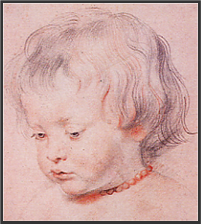 g
ample evidence (ample is the word!) of Rubens' renowned skill at
depicting flesh in the raw. In England his genius provided nine
huge decorative panels for the ceiling of the Banqueting Hall in
Whitehall, London, the masterpiece of the English architect Inigo
g
ample evidence (ample is the word!) of Rubens' renowned skill at
depicting flesh in the raw. In England his genius provided nine
huge decorative panels for the ceiling of the Banqueting Hall in
Whitehall, London, the masterpiece of the English architect Inigo
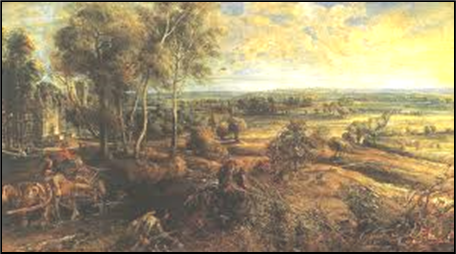 xxxxxApart from his work as a highly successful painter,
Rubens often combined his artistic skills with those of a
diplomat. Gracious in manner and able to speak five languages, he
was sent on a number
of diplomatic missions, often picking up commissions on the way.
He paid two visits to Spain, where he painted King Philip IV and
met and became friendly with the young painter Diego Velasquez. He
visited Louis XIII of France in 1622, and his successful mission
to London seven years later earned him more work as well as a
knighthood from the English king, Charles I. Yet despite his
hectic life-
xxxxxApart from his work as a highly successful painter,
Rubens often combined his artistic skills with those of a
diplomat. Gracious in manner and able to speak five languages, he
was sent on a number
of diplomatic missions, often picking up commissions on the way.
He paid two visits to Spain, where he painted King Philip IV and
met and became friendly with the young painter Diego Velasquez. He
visited Louis XIII of France in 1622, and his successful mission
to London seven years later earned him more work as well as a
knighthood from the English king, Charles I. Yet despite his
hectic life-
J1-
xxxxxBaroque was a revolt against the strict rules of classical art. It roughly spans the 17th century and was followed by Rococo, a more subtle form. In all forms of art, it is characterised by a dynamic intensity made up of movement, energy and tension, designed to appeal directly to the emotions. In painting, it began in Rome with artists like Michelangelo and Caravaggio and then moved northwards, becoming evident to varying degrees in the works of artists like Hals, Van Dyke, Velazquez, Rembrandt and Vermeer. The colours are vibrant, sensuous curves create movement, and the light is manipulated for dramatic effect. Rubens earned himself the title “Creator of Baroque”. But it is perhaps in architecture that baroque is seen in its most extravagant form. Here the new dynamic, sumptuous style produced splendid palaces and churches, with magnificent facades and ornate interiors.
xxxxxAs we have
seen, Mannerism was a reaction -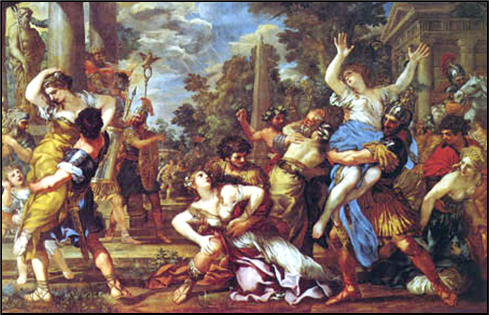 grotesque,
flaunting the classical rules of good taste.
grotesque,
flaunting the classical rules of good taste.
xxxxxBe it in painting, sculpture, architecture,
furniture or music, baroque has a common denominator -
xxxxxIn painting, as we have seen above, Rubens earned for himself the title "Creator of Baroque". His work has the vibrant colours, the powerful composition, and the sensuous curves of this dynamic movement. There is now a more conscious attempt at realism, be it in the portrayal of emotion or the more accurate rendering of tone and texture. And his work reveals, too, a masterly manipulation of light: the contrast between light and shade is heightened, thus enhancing the dramatic effect. These baroque components were evident in varying number and degree in the works of many artists, including those of Hals, Van Dyke, Velazquez, Rembrandt, and Vermeer.
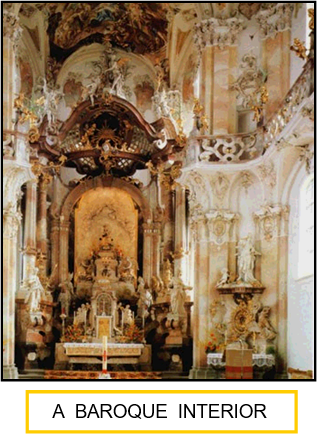
xxxxxBut as an art
form, baroque is seen at its most flamboyant and effective in
architecture and sculpture. Classical forms were used, but
classical rules of design were largely ignored. Thus Renaissance
art was taken to new heights of extravagance. The result were
buildings of immense grandeur, the external, ornate facades
supported with twisted columns and covered with florid curves and
scrolls; the inside a feast of glowing colour, amid multi-
